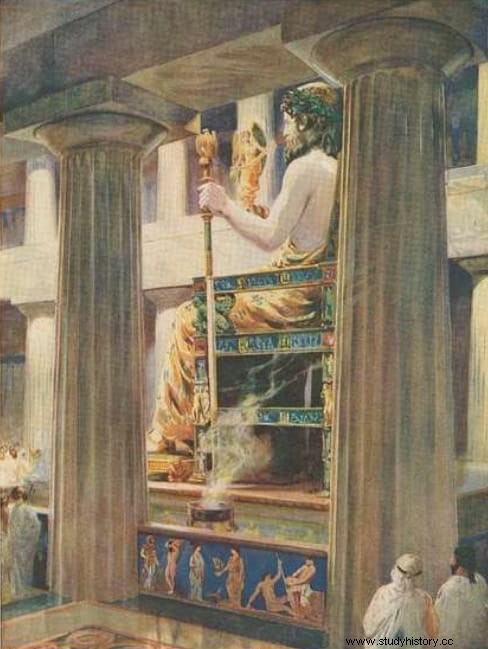In the mid-1950s, archaeologists made a sensational discovery at the site of the sanctuary of Olympia:tools for working gold and ivory, terracotta molds and a cup with an inscription appeared under a Byzantine church built in the middle of the sacred precinct. which put ΦΕΙΔΙΟΥ ΕΙΜΙ (I belong to Phidias).
It was the workshop of the famous sculptor of Antiquity, exactly in the place where Pausanias wrote that he was.
This served to confirm the fact, repeated by the sources, that Phidias had carved there the famous chryso-elephantine statue (made of gold and ivory) of Zeus, one of the Seven Wonders of the Ancient World that was inside his temple in Olympia.

It had been entrusted to Phidias, who moved to work at the Sanctuary around the middle of the 5th century BC. (470-450 BC), once the construction of the temple was completed around 457 BC. (Some authors defend a later date than 450 AD). The sculptor took 13 years to complete it, using ivory and solid gold panels as materials, supported by an interior wooden frame.
What became one of the most revered images of ancient Greece showed Zeus seated on a throne, his head crowned with an olive tree and looking down on the faithful. In his left hand he held a scepter and in his right a victory (Nike). Some details, like the sandals, were solid gold.

When it was finished and placed inside the temple, it occupied half the width of the nave and reached a height of 13 meters. According to Strabo, who must have seen it at the beginning of the 1st century BC, the statue was so large that it gave the impression that if it rose from the throne it would break the ceiling.
The truth is that to install it, the interior columns and their stylobates had to be dismantled and relocated later, also forcing the roof to be rebuilt. The statue was constantly covered in oil to protect the ivory from moisture.
The ground on which it stood, paved with large blocks of black stone, was surrounded by a raised rim to contain the falling oil, forming a reservoir that acted as a reflector making the statue appear taller.

Unfortunately, no marble or bronze copy has survived to this day, and we can only know what it was like thanks to the descriptions of the classical sources and some representations found on coins from Elis (the city in whose territory the sanctuary of Olympia was located) and Romans. Strabo himself recounts the anecdote in which Phidias reveals what he would base himself to create the statue:
According to the Roman historian Tito Livio, General Lucius Aemilius Paulus saw the statue during his visit to Olympia after defeating the Macedonians, and he was moved to the core, as if he had seen the god in person /em> .

Not only was the statue itself impressive, the throne was made of ebony and ivory, adorned with gold, jewels, paintings and reliefs. The description of Pausanias, who could see it at the beginning of the 2nd century AD, coincides with the representations on the coins.
The throne was supported on interior pillars and there were walls built as a screen so that people did not circulate under it, unlike what happened in Amiclas, where it was possible to enter under the throne of Apollo, perhaps the strangest monument in Greek antiquity.

The sanctuary and temple were damaged in the 3rd century AD. due to several earthquakes. However, the Olympic festival continued to be held there until 393 AD, after which Emperor Theodosius I banned pagan worship and closed the temples.
The sanctuary fell into disrepair, but it would still stand for three more decades, until in 426 AD. Emperor Theodosius II ordered its destruction. The temple was burned down, however the statue of Zeus was no longer there by then.
Tradition, recorded in the sources and preserved by the 11th-century Byzantine historian George Cedrenus, says that Theodosius I had it brought to Constantinople in 393 AD. There it would have been installed in the Palace of Lauso, the imperial chamberlain, who was famous in the capital for his large collection of pagan statues, all of them torn from the temples. Although Lauso was a Christian, it seems that he had a particular fondness for heroic and mythological statues, and assembled the first known collection of works of art, for aesthetic reasons.
If it was not on that date that he moved to Constantinople, it may have been in 408 A.D., when another law was enacted authorizing the removal of statues from the temples.

Almost the entire collection, according to the 12th-century historian Zonaras, was destroyed in the palace fire in AD 475, some 30 years after Lauso's own death.
Among the works that then disappeared forever was Praxiteles's Aphrodite of Cnidus, known today only from copies. However, neither Zonaras nor Cedreno mention the statue of Zeus among the works lost in the fire.
It is assumed that it was placed in the apse that crowned the great gallery of the palace, on the other side of the rotunda that served as a reception. The palace, which was situated next to the stadium, was later heavily damaged during the Nika Revolt in 532 AD. and it could have been on this occasion that the statue was finally destroyed, almost a thousand years after it was created.
